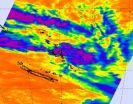(Press-News.org) The low pressure area called System 96P in the South Pacific appears to be getting organized in infrared satellite imagery from NASA. System 96P is showing signs of strong convection and that has prompted the government of Vanuatu to issue tropical cyclone warnings today.
Vanuatu is an island nation located in the South Pacific Ocean. A tropical cyclone warning is in effect today for the Sanma, Penama, Malampa and Shefa Provinces of Vanuatu. Strong winds and heavy surf are expected in the next 12 to 24 hours in the warning areas. Local updates are available on the Vanuatu Meteorological Service website at http://www.meteo.gov.vu.
At 0600 UTC (1 a.m. EST) on March 8, 2011, System 96P was located about 220 miles west-northwest of Vanuatu, near 16.3 South and 164.7 East. Maximum sustained winds are estimated between 20 and 25 knots (23 mph to 29 mph/37 kmh to 46 mph) with higher gusts.
When NASA's Aqua satellite passed over System 96P on March 8 at 14:05 UTC (9:05 a.m. EST) the Atmospheric Infrared Sounder (AIRS) instrument captured an infrared image of the storm's cloud temperatures. The imagery showed increased deep convection (rapidly rising air that forms the thunderstorms that make up a tropical cyclone) over a developing low level circulation center.
Despite some stronger convection, the western side of System 96P is in a region of high vertical wind shear. That wind shear is being generated by an upper-level low pressure area. Wind shear means winds that can weaken a tropical cyclone.
Cloud temperatures are a key in determining storm strength. The higher the cloud tops, the stronger the convection and the stronger the thunderstorms are that power a tropical cyclone. That's why infrared data from AIRS is so important to forecasters. AIRS data showed that most of the coldest, highest cloud tops and strongest thunderstorms were still east of the island nation at that time. The coldest cloud tops were as cold as or colder than -63 degrees Fahrenheit (-53 Celsius).
The Joint Typhoon Warning Center forecasters give System 96P a "fair" chance at becoming a tropical depression in the next 24 hours, and residents in the region of Vanuatu should make preparations now.
INFORMATION:
NASA infrared satellite data sees system 96P developing tropically near Vanuatu
2011-03-10
ELSE PRESS RELEASES FROM THIS DATE:
PBS-Bio uncovers how Unibioscreen drug kills cancer
2011-03-10
MESA, Ariz. — March 8, 2011 — Predictive Biomarker Sciences (PBS-Bio) has uncovered how the experimental drug UNBS1450, produced by Unibioscreen, kills cancer cells.
Previous studies have shown that over-activity of a gene known as MCL1 can cause cancer cells to grow out of control. PBS-Bio, which is owned in part by the non-profit, Phoenix-based Translational Genomics Research Institute (TGen), co-discovered that UNBS1450 effectively shuts off the gene and induces apoptosis, the cancer cell's normal process of cellular death.
"It's a very nice candidate drug," said ...
New mouse models generated for MYH9 genetic disorders
2011-03-10
WASHINGTON, D.C. (March 9, 2011) -- Researchers have created the first mouse models of human MYH9 genetic disorders, which cause several problems -- including enlarged platelets and sometimes fatal kidney disease.
The MYH9 gene makes non-muscle myosin II-A protein. This protein plays a critical role in helping cells move to their correct home during embryonic development. Later in life, the protein continues its involvement in cell migration, cell-cell adhesion and also in maintaining cell shape, says Yingfan Zhang, Ph.D., a postdoctoral fellow at the National Heart, ...
Researchers in France and Austria find novel role for calcium channels in pacemaker cell function
2011-03-10
WASHINGTON, D.C. (March 9, 2011) -- Pacemaker cells in the sinoatrial node control heart rate, but what controls the ticking of these pacemaker cells? New research by Angelo Torrente and his colleagues of the M.E. Mangoni group's, reveals, for the first time, a critical functional interaction between Cav1.3 calcium ion (Ca2+) channels and ryanodine-receptor (RyR) mediated Ca2+ signaling.
The study also sheds light on a long-standing debate regarding the relative contributions of the 'funny current' generated by ion channels and the RyR dependent spontaneous diastolic ...
New genetic deafness syndrome identified
2011-03-10
WASHINGTON, D.C. (March 9, 2011) -- Ten years ago, scientists seeking to understand how a certain type of feature on a cell called an L-type calcium channel worked created a knockout mouse missing both copies of the CACNA1D gene.
The CACNA1D gene makes a protein that lets calcium flow into a cell, transmitting important instructions from other cells. The knockout mice lived a normal life span, but their hearts beat slowly and arrhythmically. They were also completely deaf.
Today at the 55th Annual Biophysical Society Meeting in Baltimore, an international team lead ...
Newly identified spider toxin may help uncover novel ways of treating pain and human diseases
2011-03-10
WASHINGTON, D.C. (March 9, 2011) -- Spider venom toxins are useful tools for exploring how ion channels operate in the body. These channels control the flow of ions across cell membranes, and are key components in a wide variety of biological processes and human diseases.
A newly identified toxin from the American Funnel Web spider acts on T-type and N-type calcium channels, researchers from the University of California at Riverside have discovered. The toxin offers a new target for studying T-type channels, which play a role in congestive heart failure, hypertension, ...
Gene fusion mechanisms offer new clues to origin of pediatric brain tumors
2011-03-10
March 10, 2011 – A detailed analysis of gene fusions present at high frequency in the most common pediatric brain tumors has been performed for the first time in a study published online today in Genome Research (www.genome.org), shedding new light on how these genomic rearrangements form in the early stages of cancer.
Genomic rearrangements, genetic changes that alter the structure of chromosomes, have a positive role in evolution by creating genetic diversity and new genes; however, rearrangements can also predispose to or potentially initiate diseases such as cancer. ...
Web-crawling the brain
2011-03-10
VIDEO:
Researchers have created a three-dimensional nanoscale model of a neural circuit using electron microscopy. As a result, the researchers can crawl these vast neural networks much as Google crawls Web...
Click here for more information.
BOSTON, Mass. (March 9, 2011) — The brain is a black box. A complex circuitry of neurons fires information through channels, much like the inner workings of a computer chip. But while computer processors are regimented with the deft economy ...
UK doctors consistently oppose euthanasia and assisted suicide
2011-03-10
Los Angeles, CA (March 10th, 2011) – A review of research carried out over 20 years suggests that UK doctors appear to consistently oppose euthanasia and physician-assisted suicide (PAS). The findings - which appear in the latest issue of the journal Palliative Medicine, published by SAGE - highlight a gap between doctors' attitudes and those of the UK public.
The study, carried out by Dr Ruaidhrí McCormack and colleagues Dr M Clifford and Dr M Conroy at the Department of Palliative Medicine, Milford Care Centre, Limerick, Eire, searched through literature from 1990 to ...
NIST electromechanical circuit sets record beating microscopic 'drum'
2011-03-10
BOULDER, Colo.—Physicists at the National
Institute of Standards and Technology (NIST)
have demonstrated an electromechanical
circuit in which microwaves communicate with
a vibrating mechanical component 1,000 times
more vigorously than ever achieved before in
similar experiments. The microscopic
apparatus is a new tool for processing
information and potentially could control the
motion of a relatively large object at the
smallest possible, or quantum, scale.
Described in the March 10 issue of Nature,* the NIST experiments created strong
interactions between ...
Researchers find smoking may increase risk for lung disease
2011-03-10
Boston, MA – A team of researchers at Brigham and Women’s Hospital (BWH) have found that approximately one out of every twelve adult smokers have abnormal lung densities present on chest computed tomography (CT) images suggestive of interstitial lung disease which is associated with substantial reductions in lung volumes. In addition, despite being positively associated with smoking, these lung densities were inversely not associated with emphysema. This research is published online on March 10th in the New England Journal of Medicine.
It is increasingly acknowledged ...

